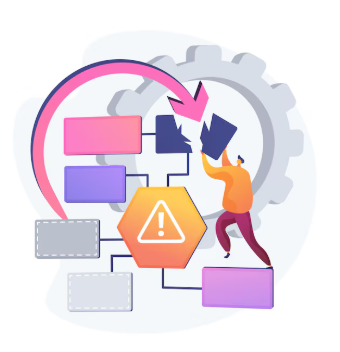Risk-Proof Your Project Timeline with the Power of Gantt Charts

Comments are closed.

Every project has a villain—sometimes it’s scope creep, other times it’s a surprise budget blowout or a critical team member quitting mid-way. These villains are known collectively as risks, and knowing how to deal with them is what separates successful projects from costly disasters.
What are the different types of risks you can “possibly” face in project management—and how a simple yet powerful tool, the Gantt chart, can be your secret weapon in spotting, avoiding, and handling them before they derail your success ? Let’s see!
In project management, project risks are potential events or conditions that may negatively impact a project’s objectives like scope, timeline, cost, or quality.
While the word “risk” often implies danger, in project management, it’s more about uncertainty. Some risks can present opportunities (like finishing early), but most project risk discussions focus on potential threats to successful delivery. And there are ways to stay in control.
Every project has risks.
Even with perfect planning, there are always variables outside your control—people, technology, regulations, weather, vendors, market conditions, etc.
Risks can be internal or external.
Internal risks come from within the project (e.g., team availability), while external risks arise from outside factors (e.g., new regulations or market shifts).
Risks can affect different project areas:
1. Scope – Changes in project requirements
2. Schedule – Delays in task completion
3. Budget – Cost overruns or funding shortfalls
4. Resources – Unavailable or overbooked personnel/equipment
5. Quality – Deliverables not meeting standards

Scope risk refers to the potential for a project’s work to expand, shift, or become unclear, leading to missed deadlines, increased costs, and confusion among stakeholders. This is often known as scope creep—when new features, tasks, or goals are added without proper review or approval.

⚠️ Common Causes of Scope Risk:
◦ Unclear or incomplete project requirements
◦ Stakeholders adding new requests mid-project
◦ Lack of a formal change control process
◦ Overpromising during planning or sales
◦ Poor communication between teams and clients
🛠 How Gantt Charts Help:
• Gantt charts provide a visual overview of tasks, dependencies, and deadlines, helping everyone aligned on what’s in and out of scope. If new tasks start showing up without matching deadlines or dependencies, it’s a red flag you can spot instantly.
• Prevents unrealistic additions by showing time constraints.
• Detailed project charters, work breakdown structures (WBS), and stakeholder approvals. A clearly defined scope at every step.
• Visual timelines help spot unplanned additions and overflows.
• See how added scope affects linked tasks.
Schedule risks refer to the possibility that your project won’t be completed on time. These risks arise when planned tasks take longer than expected—or when delays in one part of the project cause a domino effect on the rest.
⚠️ Common Causes of Schedule Risk:
◦ Unrealistic time estimates
◦ Delays in task dependencies
◦ Unexpected resource unavailability (sick leave, turnover, etc.)
◦ Scope creep adding unplanned tasks
◦ Poor task sequencing or lack of buffer time
◦ Vendor or external delays

🛠 How Gantt Charts Help:
• Gantt charts are visual control center for timelines.
• With visual timelines, Gantt chart helps to plan sequences carefully
• Gantt chart provides timeline clarity, supports in seeing the full project schedule at a glance.
• Understand how a delay in one task affects others, and handle dependencies accordingly.
• Focus on tasks that directly impact project completion.
• Milestone monitoring, to track progress toward key goals to stay on pace.
• Support proactive adjustments, to easily reschedule tasks when issues arise.
Resource risks occur when the people, equipment, or materials essential to a project become unavailable or are used inefficiently, potentially derailing your timeline and budget.

️ ⚠️Common Causes of Resource Risks:
◦ Over-allocation: Too many tasks for limited personnel or equipment.
◦ Skill gaps: Team members lacking required expertise for specific tasks.
◦ Unplanned absences: Illness, turnover, or other unexpected changes.
◦ Supply chain issues: Delays in procuring materials or equipment.
◦ Budget constraints: Insufficient funding to secure the necessary resources.
🛠 How Gantt Charts Help:
• Gantt charts helps to clearly identify who is working on what, and when.
• As a visual map, Gantt chart helps spot bottlenecks, if any resource is overbooked or underutilized.
• With Gantt, it’s easy to adjust schedules and reassign tasks proactively if resources become strained.
• Gantt chart as it boosts transparency by keeping stakeholders informed about resource usage and potential shortages.
Budget risks are the potential threats that a project will exceed its planned costs, leading to financial overruns, reduced profit margins, or even project failure.
⚠️ Common Causes of Budget Risk:
◦ Unrealistic cost estimates
◦ Scope creep adding unplanned expenses
◦ Unexpected price increases in materials, tools, or labor
◦ Poor tracking of expenses or lack of budget control
◦ Delays that increase costs over time (extended resource use, penalty fees)
◦ Currency fluctuations (for international projects)

🛠 How Gantt Charts Help:
While Gantt charts aren’t accounting tools, they offer powerful indirect control over budget risks.
• Gantt chart helps correlate delays or scope additions with potential cost impacts.
• Transparency in who is connected to tasks – Know who is working and when, which ties directly to cost.
• Gantt chart highlights dependencies,preventing domino-effect delays that inflate expenses.
• Gantt chart helps in tracking progress and spot slippage early, so team can adjust to avoid costly overruns.
Operational risks are risks that stem from internal processes, systems, or human factors that can disrupt the project’s ability to run smoothly. External risks arise from outside the organization and are usually beyond the project team’s control.

⚠️ Common Causes of Operational & External Risk:
◦ Process inefficiencies or outdated workflows
◦ System failures or technical glitches
◦ Poorly defined roles and responsibilities
◦ Team miscommunication or conflict
◦ Lack of documentation or standard procedures
◦ Economic shifts (inflation, funding cuts)
◦ Weather events or natural disasters
🛠 How Gantt Charts Help:
Gantt charts are powerful for identifying and adapting to both operational and external risks.
• With Gantt’s task visualization, it’s easier to spot where internal process risks may cause delays.
• Gantt’s dependency mapping helps understand how supplier delays or legal changes could ripple through the timeline.
• With Gantt, it’s easier to shift tasks and reassign resources in response to unexpected events
• Gantt also ensures compliance and approvals happen on time
• Gantt helps in team coordination, keeping everyone aligned when reacting to risk
Risk doesn’t disappear—it just gets smarter. With the right tools and planning, you don’t eliminate risk; you lead it. Gantt charts is one such tool that turn complex timelines into easy-to-read visual maps. But they also do something deeper: they give transparency. When your team, stakeholders, and clients can all see the flow, the risks become easier to discuss, anticipate, and reduce collaboratively.
Risks will always be part of the project equation—but panic doesn’t have to be.
By using Gantt charts as more than a pretty timeline—by treating them as a risk radar—you equip your team to respond smartly and quickly.
Plan visually. Act confidently. Deliver predictably.
Have you used Zace Gantt charts to overcome project roadblocks?